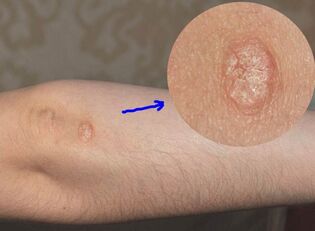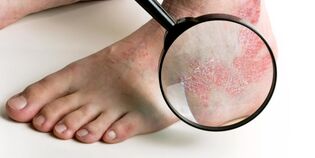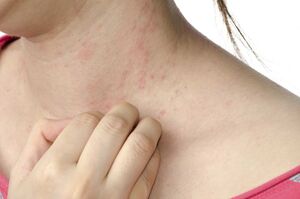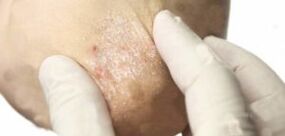Psoriasis is an inflammatory skin disease. It occurs when the immune system is not functioning properly. The development of the disease is divided into clear stages: appearance, progression, stabilization and regression. The different stages of psoriasis differ in the appearance of spots and rashes, painful itching and extensive skin inflammation.
Why is it necessary to distinguish between the stages of development of the disease and what are the features of the course of psoriasis at the beginning of development and in the healing process?
Why you need to know the stages of psoriasis

The division of psoriasis into stages is used by doctors for the correct choice of therapeutic methods. A complex of drugs and external agents prescribed to treat inflammation depends on the stage of development of the disease. At the beginning of the manifestation of the disease, general therapy is required: vitamin complexes, diet, external aseptic treatment of the rash, for example, a course of UV procedures. Also prescribed drugs that stimulate the cleansing of the intestines, blood vessels, liver. Be sure to carry out the correction of the psychoemotional state - by a neuropathologist or psychologist.
In the initial stage of the disease, they do not use powerful drugs that extinguish the immune system, do not prescribe hormonal ointments. These drugs have a large list of side effects, so they are only prescribed when it is impossible to do without them.
Psoriasis: treatment in acute phase and in remission
In the case of an acute progressive course of the disease, several drugs of various actions are prescribed. Immunosuppressants and glucocorticosteroids are often used to relieve inflammation and reduce itching. External treatments are complemented by photochemical, ultrasound and laser therapy. Also, agents are prescribed for antiseptic treatment of damaged skin.
In a stabilized state, they continue to take anti-inflammatory hormonal drugs, gradually reducing their dose. To restore damaged skin, ointments with a regenerating effect are prescribed.
In remission: support the body. Proper nutrition, take complexes of vitamins and minerals to restore immunity.
Timeliness of treatment
The earlier you start treatment, the easier it is to keep your psoriasis under control. Prompt therapy limits the spread of skin inflammation, reduces its extent and prevents subsequent relapses of peeling. Since psoriasis is often mistaken for an allergic rash at an early stage, it is necessary to know its initial signs in order not to miss the appearance of a skin disease.
Note: Doctors are still investigating the causes of psoriasis. But psoriatic skin inflammation is definitely known not to be contagious. It cannot be picked up by a sick person or an infection in case of injury. This is our personal failure in the human body.
The cause of psoriasis is immune failure, which can be caused by various factors. Severe stress, poisoning (including potent drugs, industrial emissions, alcohol), previous infection.
Psoriasis is difficult to treat. The disease is prone to relapse, relapse. And the therapy itself is symptomatic. It consists in preventing the appearance of new spots and relieving existing skin itching.

What stage of psoriasis is called initial? How to distinguish early psoriasis from diathesis rash? And how will the disease develop in the future?
Psoriasis: initial phase
The first appearance of psoriasis on the skin looks like a pimple. Most often, the rash appears in the folds of the elbows and knees or in places where clothes are firmly pressed to the body (for example, below the waist belt). Rashes can also appear along the edge of the hair and under the hair, around the fingernails and on the nails. Sometimes psoriasis occurs on the feet and palms.
Almost always, psoriasis manifests itself symmetrically: on the elbows of both hands or on both sides of the lower back or on two knees. The pimples themselves (in medical terminology - papules) at the initial stage have a modest appearance. They have:
- Pink or red;
- Sharp and blurry edge;
- Small size - the pimple at the base does not exceed 2 mm;
- Flat shape: the small pimples pointed at the beginning of the disease have almost no swelling, so they look like spots.
As the disease progresses, flaking skin flakes appear on the pimples. They are gray or silver, against the background of a red pimple they appear white.
The appearance of scales is accompanied by severe itching. If you can't resist and scratch, the scales are removed, exposing the shiny areas of the young pink skin below. It is very thin, vulnerable, with prolonged scratching of itchy papules - it is injured, it bleeds.
The initial stage of psoriasis lasts up to 4 weeks.
Psoriasis: stage of progression
In the progressive stage, the individual pimples merge into a common spot, forming the so-called psoriatic plaques. They are raised above the surface of the skin and are almost completely covered with peeling. At the edges of the psoriatic plaques, there is a non-flaking pink-red border.
The presence of a border is a sign of a progressive stage of the disease. The rim width is 1-2 mm. The skin on it is inflamed and resembles parchment paper in structure.
The border represents the expansion area of the spot. This is skin that is already inflamed, but not yet peeling. After a while, it will also be covered with scales. And the patch will expand to cover new areas of the skin and form a new, wider border.
With the active development of the disease, adjacent points merge with each other. At some point, a large, inflamed red spot may form on the human body.
Psoriatic plaques are very itchy, they give a person unpleasant sensations, disrupting his work, rest and sleep. They grow, occupy a large area and form a new rash on clean, healthy skin.
The main sign of the progressive phase is the appearance of new rashes. As soon as the new pimples and spots stop appearing, the next stage of psoriasis begins - stationary. This is not yet a complete victory, but it is already a turning point towards recovery.

In the progression phase, psoriasis is almost always accompanied by weakness, fatigue, weakness. Depression is common. Possible temperature.
The duration of the progressive phase of psoriasis can be long, several months.
Psoriasis: stationary stage
The main sign of the stationary stage is the cessation of the appearance of new spots and rashes. At the same time, itching also decreases, it becomes more bearable. The rash loses its bright color, becomes discolored, becomes invisible. This is also one of the signs that the process is stabilizing.
The pink bands around the perimeter of the plaques disappear when the inflammation stops spreading. Active exfoliation and healing begins, regeneration of new healthy skin.
It is noted with the naked eye that the peeling increases in the stationary phase. The scales completely cover the entire surface of the psoriatic point, leaving no room for the edges. Psoriasis takes on the characteristic scaly appearance commonly recognized by the general public.
Extended peeling in the stationary phase is not dangerous. When all the dead cells come out of the surface of the psoriatic spot, healthy skin with a slight light shade will remain in place.
Other signs of progression or stabilization
In addition to the appearance of rashes, spots and peeling, there are a number of other signs that can be used to judge the development of the disease. This is the nature of the sensations of itching (strong or tolerable), general condition, depressed mood. And also the presence of temperature.
In the initial stage, itching is variable and the rash is incomprehensible. Also, the itching intensifies every day. In the acute stage of psoriasis, it becomes intolerable. It disrupts sleep, rest, interferes with work. The person becomes irritable because the itchy sensations do not give him a chance to rest.
In the stationary phase, the itching subsides. Every day - a person feels better. The general state of the psyche changes, negativity and depressive moods weaken. The duration of the stationary phase is several weeks, from 2 to 5.
Diminishing psoriasis
The fading stage of psoriasis is the almost complete disappearance of plaques, spots, redness, inflammation, itching. At this stage of the disease, psoriasis only remembers the different pigmentation of the skin. In place of the previous psoriatic spots, it looks lighter. The surface of healthy skin has a darker shade.

In some cases, the so-called hyperpigmentation is formed. The skin at the site of the psoriasis spots does not become lighter, but darker. In any case, the differences in skin pigmentation will be visible for another one to two months.
Psoriasis after recovery: possibility of relapse
The possibility of psoriasis recurrence is determined by the person's lifestyle, diet, allergic mood and the state of the body as a whole. It is also determined by the amount of toxins in his body, blood, liver. It is possible to reduce the likelihood of repeated skin inflammation if you strengthen the immune system and cleanse the body of toxins in the liver, blood vessels and intestines.
Seasonal relapses of psoriasis are often rare after cleansing. A person remains susceptible to the disease, but the likelihood of it occurring is greatly reduced.
Cleansing the body of toxins and taking vitamin and mineral complexes help strengthen immunity. This is especially important if immunosuppressants were used during the treatment, in the progressive stage of psoriasis. Their need was due to the work of inflammatory mediators. After the suppression of autoimmune defenses, it is necessary to restore immunity.
Clinical manifestations
Psoriasis is characterized by monomorphic eruptions in the form of papules (nodules) of various sizes, when they merge, plaques form that can spread throughout the skin.
At the onset of the disease, in most cases, the rash is limited and is represented by individual plaques in places of its preferred localization (scalp, elbow extensor surface, knee joints, sacrum region, etc. ).
Plaques are clearly delimited by healthy skin, bright pink or deep red, covered with silvery-white scales, when scraped, it is possible to obtain a triad of phenomena characteristic of psoriasis - "stearin stain", "terminal film", "dew of blood". . .
There are 3 clinical stages of psoriasis: progressive, stationary and regressive.
Classification
Depending on the degree of the inflammatory process, the predominant localization of the rashes, the severity of the patient's condition and other clinical signs, there are common plaque, exudative, arthropathic, pustular psoriasis, psoriatic erythroderma, fold psoriasis, psoriasis of the palms of the hands and soles of the feet. It should be noted that several clinical variants can exist simultaneously in one patient.
Exudative psoriasis is characterized by a pronounced inflammatory reaction of the skin, which is manifested by the presence of lamellar crusts on the surface of the plaques, sometimes multilayered, looking similar to a puff cake (in these cases, this formof psoriasis is called rupioid). When the flaky scabs are removed, a weeping surface is exposed.
Arthropathic psoriasis in the clinical picture presents, in addition to the usual plaque eruptions, joint damage, often small, distal, less often large.
Arthropathy can occur in the presence of skin lesions or precede them. Psoriatic arthritis manifests itself with pain, swelling, limited mobility in affected joints of varying degrees of intensity, from minor arthralgia of individual joints to generalized injury and patient disability. The possibility of arthropathic psoriasis is greater in patients with severe skin manifestations (psoriatic erythroderma, pustular psoriasis), but a combination of severe joint damage with relatively limited rashes is possible.
Pustular psoriasis can be generalized (Tsumbusha) and limited, involving the palms of the hands and soles of the feet (Barbera). Stressful situations, infections, general or local irrational therapy contribute to the appearance of this severe form of psoriasis.
Generalized pustular psoriasis is manifested by fever, leukocytosis, increased ESR and a severe general condition. Suddenly, against the background of a bright erythema, small superficial pustules appear, accompanied by burning, pain, which can be localized in the area of ordinary plaques and on the previously unchanged skin. New foci of pustulation appear paroxysmal, occupying large areas of the skin. The fused pustules cause the detachment of the epidermis in the form of "purulent lakes", erythroderma can develop.
Limited pustular psoriasis is more common, the rash is mainly localized on the palms and soles of the feet in the form of pustules against the background of erythema and skin infiltration. The course, compared to the generalized one, is milder, with a satisfactory but persistent general condition, with frequent relapses. Local irritating therapy is a provoking factor.
Psoriatic erythroderma is a severe form of psoriasis that develops with a gradual progression of the psoriatic process and the fusion of the elements of the plaque to the defeat of the entire skin, characterized by acute hyperemia, edema, skin infiltration with abundant lamellar peelinglarge and small, less often pityriasis. Subjective: severe itching is often noted. The disease can begin with erythroderma. The general condition worsens (fever, weakness, lymph node reaction, heart failure, impaired liver and kidney function, changes in blood tests, hair loss, etc. ).
Psoriasis of the folds is more common in children and the elderly, especially in patients with diabetes mellitus. The lesions are located in the armpits, under the mammary glands, in the perineum, in the inguinal-femoral folds, in the navel and are characterized by sharp edges, saturated red color and light peeling.
Psoriasis of the palms of the hands and soles of the feet can exist in isolation or simultaneously with damage to other areas of the skin, is characterized by the formation of hyperkeratotic foci with clear boundaries, covered with scales that are difficult to scrape and the presence of crackspainful. The characteristic psoriatic triad is difficult to evoke.
Three clinical stages of psoriasis
Progress phase. Under the influence of provoking factors (trauma, psycho-emotional stress, infectious diseases, inadequate treatment methods, etc. ), an exacerbation of the disease can develop with the appearance of abundant small nodules prone to peripheral growth and the formation ofplaques of various sizes and contours, which can be isolated or occupy large areas of the skin up to universal skin lesions.
In the progressive phase, an isomorphic reaction symptom (Kebner phenomenon) is characteristic, characterized by the fact that typical psoriatic eruptions appear in the site of a lesion, even a minor one.
Stationary stage. In the stationary phase, the emergence of new elements ceases and the tendency to peripheral growth of existing plaques disappears.
Regressive phase. The regressive stage is characterized by a decrease in the intensity of the color of the plaques, their flattening, a decrease in desquamation, infiltration, resorption of elements with the subsequent formation of foci of hypo or hyperpigmentation at the site of previous rashes.
Treatment
Treatment of psoriasis is aimed at suppressing the proliferation of epithelial cells and eliminating the inflammatory process and is prescribed taking into account the anamnestic data, the form, stage, prevalence of the process, concomitant diseases, ageand the patient's sex, contraindications to a certain method of treatment or drug.
For mild and limited manifestations of psoriasis, local external therapy in the form of salicylic ointment, naphtha preparations, tar or emollient ointments is sufficient. Severe forms of the disease require complex systemic treatment with the use of detoxifying, desensitizing, anti-inflammatory drugs of different groups, physiotherapeutic methods of therapy, external drugs, etc.
This section will present the most modern and effective methods and means available for psoriasis therapy.
Systemic therapy
There are peculiarities in the management of patients in the different phases of the psoriatic process. Treatment of the advanced stage requires special care. During this period, emodez is prescribed intravenously drip, 30 percent. sodium thiosulfate solution e. v. , 10% solution of calcium gluconate, with concomitant hypertension, it is recommended to introduce a solution of magnesium sulfate; emollient creams or 1-2 percent are used externally. salicylic ointment.
Aromatic retinoids.Acitretin (neotigazone) - a representative of the second generation of monoaromatic retinoids is used to treat severe forms of psoriasis at a dose of 10 to 20-30 mg per day, depending on the severity of the skin process. The mechanism of action of acitretin is to inhibit the proliferation of epidermal cells, normalize the keratinization processes. The drug is especially effective in combination with PUVA therapy. When prescribing acitretin, one should not forget about its teratogenic effect.
Cytostatics. Methotrexate is used in cases of persistent psoriasis and in the presence of contraindications to other treatment methods, being a folic acid antagonist, it acts mainly on actively proliferating cells. Very toxic. There are many methods of application, preferably intramuscular injection once a week under strict laboratory supervision.
Immunosuppressants.Ciclosporin-A is prescribed in cases of severe and widespread psoriasis resistant to other therapies. This drug has an immunosuppressive action, has an inhibitory effect on cell growth processes, suppresses the secretion of activated lymphocytes of cytokines and the expression of interleukin-1 receptors on immunocompetent cells. In psoriasis, it is prescribed at the rate of 5 mg per 1 kg of body weight per day.
Non-steroidal anti-inflammatory drugsare prescribed for arthropathic psoriasis, as well as for the reduction of acute inflammation in exudative psoriasis and erythroderma. The daily doses of drugs and the duration of treatment depend on the intensity of the pain syndrome, the degree of inflammation and individual tolerance.
The use of systemic corticosteroid drugs in the treatment of psoriasis is considered inappropriate, leads to the development of torpid forms of the disease resistant to various types of therapy. In case of severe arthropathic psoriasis, intra-articular administration of prolonged corticosteroids is possible, the dose and duration of treatment depend on the size of the affected joint and the degree of inflammation.
Physiotherapy treatments.One of the most effective treatment methods is PUVA therapy or photochemotherapy (PCT). PCT is a combined application of long-wave ultraviolet radiation (wavelength 320 to 420 nm) and photosensitizing furocoumarin drugs. The use of photosensitizers is due to their ability to increase the skin's sensitivity to ultraviolet rays and stimulate the formation of melanin. PUVA therapy leads to inhibition of cell proliferation, suppression of pathological keratinization, affects prostaglandin metabolism and permeability of cell membranes. The peak of the photosensitizing effect occurs 1-3 hours after taking 8-methoxypsoralen. The dose of the drug is selected taking into account the patient's weight. Procedures are released 3-4 times a week, for a course of 20-25 sessions.
Local PCT is also used using external photosensitizers.
The combined use of PUVA therapy and retinoids is called Re-PUVA therapy. It has the highest clinical effect in cases of severe psoriasis.
Selective phototherapy (SFT) - ultraviolet irradiation in the medium wave spectrum (wavelength 280-320 nm) without using photosensitizers. SFT is used for less pronounced manifestations of the disease, the presence of contraindications to the appointment of PUVA therapy.
How to recognize psoriasis at an early stage
Psoriasis treatment is most effective in the early stages. Therefore, it is so important to make a diagnosis in time. Only a dermatologist can tell you if you have psoriasis or some other skin disease. However, you yourself can recognize this disease in yourself by several characteristic signs:
- Most often, psoriasis occurs initially on the folds of the arms and legs, on the hairline or where clothes are in close contact with the body or rub under the belt of trousers, various elastics or straps.
- At the onset of the disease, a very itchy rash appears, covered with gray or silvery skin scales that can be removed very easily.
- If you remove the scale, you will see a thin, shiny and slightly moist skin underneath.
- If you scrape the plaque with something like a putty knife, removing the scales, blood will appear on the stain in the form of tiny droplets. However, it is better not to use the latter method for self-determination of psoriasis - it is very easy to infect it.
To be completely sure, it is necessary to consult a doctor, as patients themselves often confuse psoriasis with various types of lichen or allergic dermatitis and use unsuitable means for treatment.
What to do if you find symptoms of the early stage of psoriasis?
Psoriasis cannot be cured once and for all, so the main goal of therapy is to achieve a stable and longest possible remission. You should be aware that without proper treatment, psoriasis quickly becomes chronic - flare-ups can occur up to 9 times a year, lasting up to 15 days.
What to do if you suspect you have psoriasis? Often people, having discovered the signs of this disease in themselves, make a big mistake, resorting to "heavy artillery" - hormonal ointments (so-called topical glucocorticosteroids or THCS), without consulting a doctor. Usually, patients explain such a step by the fact that they allegedly heard from friends that such funds help quickly. This is a big mistake!
What is the danger of such self-medication? Hormonal ointments for psoriasis have many side effects and contraindications. It is highly undesirable to use them without a doctor's strict recommendation on the duration of use, frequency, area of application on the body, and even without taking into account the individual characteristics of your own body.
For effective treatment of early psoriasis, non-hormonal agents such as zinc pyrithione should be used. Zinc pyrithione, or active zinc, is a very effective remedy for the treatment of psoriasis, which has a complex effect:
- suppresses excessive proliferation of skin cells and inflammation, reducing flaking and psoriatic plaque formation;
- relieves itching;
- protects damaged skin from bacterial and fungal infections;
- restores the lipid layer and the protective functions of the skin.
























